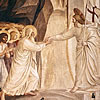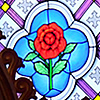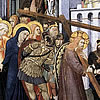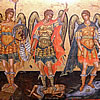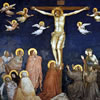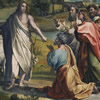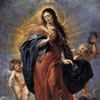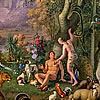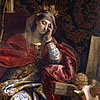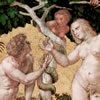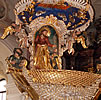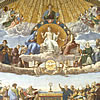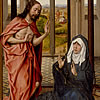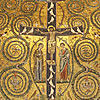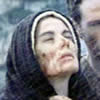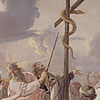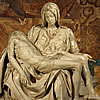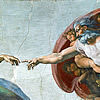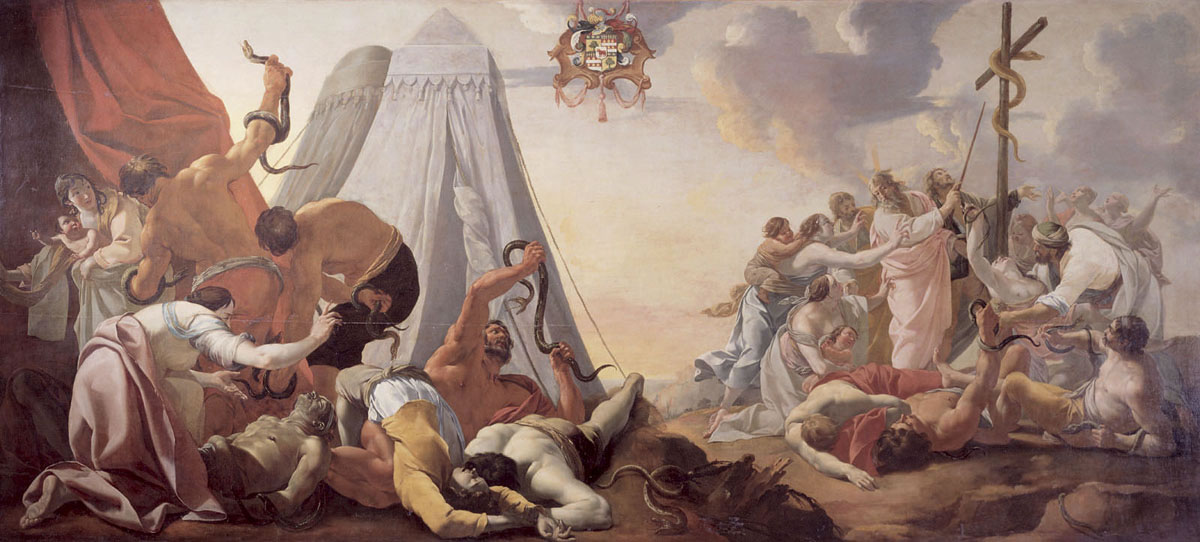

The Brazen Serpent
In the Old Testament, the Israelites complained endlessly at their plight despite being freed from Egyptian slavery and the wonders they have experienced such as the crossing of the red sea, and the pillars of cloud and fire that accompanied them. In one of these instances, God allowed poisonous seraph serpents to bite some of the Israelites who died. The Israelites, once again, realized their mistake and asked God to spare them from this plague. Through the intercession of Moses, God said:
Make a seraph and mount it on a pole and everyone who has been bitten will look at it and recover.
Moses did as he was told, and all those who were bitten and looked at the bronze serpent recovered. We can find this episode in Chapter 21 in Book of Numbers.(Numbers 21:4-9)
On the left side of the painting, we see Israelites being bitten by snakes. Some are green or dark indicating death has already vanquished them. Behind them are tents indicating they were still in a journey to the Promised Land. On the right, we see Moses symbolized by rays coming out of his head. (Whenever Moses spoke to God, his face would shine, so he is always portrayed with a shining face.) He is pointing to the bronze serpent he lifted up on a pole as a way of instructing the people that they need to look at it.
The interesting thing that Vouet does in his painting is to depict the pole as a cross – even if scripture does not describe it as such. What Vouet is pointing out is that there is a connection between these episodes in the Old Testament and the crucifixion of Christ. This is what we will tackle in this Art Speaks.
Three times in the Gospel of John, Christ mentions he will be “lifted up” and in all circumstances, the context is his forthcoming crucifixion.
And when I am lifted up from the earth, I will draw everyone to myself.”
He said this indicating the kind of death he would die.
John 12:32-33
So Jesus said (to them), “When you lift up the Son of Man, then you will realize that I AM, and that I do nothing on my own, but I say only what the Father taught me.
John 8:28
‘And just as Moses lifted up the serpent in the desert, so must the Son of Man be lifted up, so that everyone who believes in him may have eternal life.’
For God so loved the world that he gave his only Son, so that everyone who believes in him might not perish but might have eternal life.
John 3:14-16
The juxtaposition of being lifted up, and giving eternal life in John 3:14-16 cannot be clearer: Jesus must be crucified so that all those who believe in him will not perish just like all those who look up at the bronze serpent lived despite being bitten. It should be interesting that the creature that “poisoned” human nature to the point of physical and spiritual death in the Garden of Eden is a serpent. So Christ, through this typology, is the antidote to the poison of the devil symbolized by the serpent.
It is curious why God would ask Moses to fashion a bronze serpent as the antidote to a serpent bite. Could it not have been a bronze lamb? That would be a clear indicator of Christ who is the “Lamb of God.” There is no clear teaching on this; however we can consider that the serpent is a symbol of death, and in order for Christ to save us he must become “death” on the cross. We can also consider another analogy in the material of bronze. It is an alloy of two metals: tin and copper – just like Christ is one person with two natures: God and man1. If we consider these, we can see Christ as the Brazen Serpent on the cross painted by Vouet.
In Christ’s conversation with Nicodemus, he said “Moses lifted up the serpent” whereas the Septuagint says, “Moses mounted a serpent on a pole.” Christ substituted the verb implying glorification. Jesus is exalted to glory by his cross and resurrection, represents healing for all2. The Israelites had to “look up” because the bronze serpent was lifted up on a pole. Because Christ is “lifted up” on the cross, we also need to “look up” to see him. In any language, when we “look up” at someone, we venerate that person. So when we “look up” at Christ we worship him on his throne – the cross.
The cross is a stumbling block for the Jews for it is an instrument of torture by the Romans. It was a symbol of death. How can they believe that Jesus is the Messiah if he was a victim of this cruel torment? But Vouet makes it clear in his painting that the cross represents the glory of Christ for it is God’s instrument of salvation. It is our symbol for eternal life. We are not saved from the cross, but through it. Likewise, we are not saved from suffering, but through it.
1 The analogy of copper fails technically because we believe the two natures of Jesus do not mingle – they are completely distinct from one another. However, as a simple analogy it can work.
2 Footnotes John 3:14. New American Bible Revised Edition



